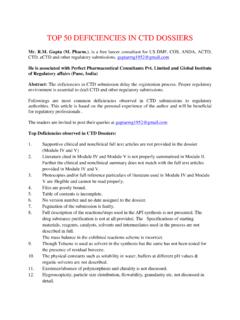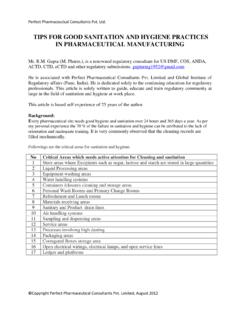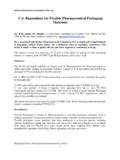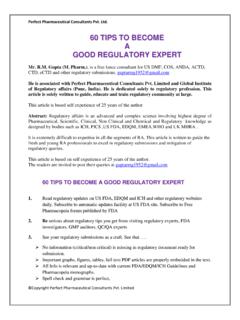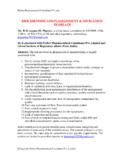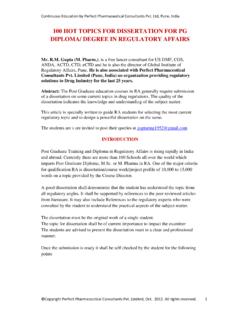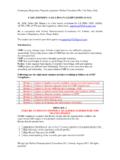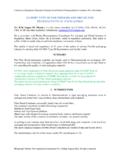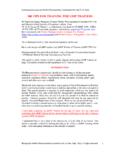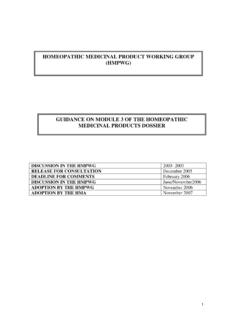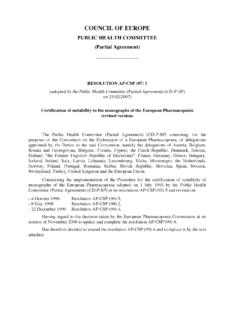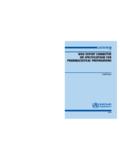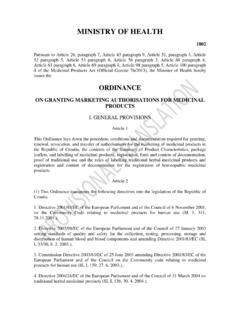Transcription of TOP FDA Comments of Impurity Profiling - Medical device
1 Continuous Education by Perfect Pharmaceutical Consultants Pvt. Ltd, Pune, India Perfect Pharmaceutical Consultants Pvt. Limited, November 2012 1 TYPICAL FDA Comments ON Impurity Profiling IN CTD/CEP/DMF SUBMISSIONS By Rajkumar Gupta, Managing Director Perfect Pharmaceutical Consultant Pvt. Ltd and Director Global Institute of Regulatory affairs, Pune Mr. Gupta (M. Pharm.), is a free lancer consultant for US DMF, COS, ANDA, ACTD, CTD, eCTD and other regulatory submissions. He is associated with Perfect Pharmaceutical Consultants Pvt. Limited ( ) and Global Institute of Regulatory affairs (Pune, India). He is dedicated solely to pharmaceutical regulatory profession. He is well recognized GMP auditor and cGMP Trainer of Trainers (cGMP TOT) for Pharmaceuticals (Parenteral/Liquid Orals/ Tablets/Capsules/Vaccines/Beta lactam) /API/Herbal/ Medical Devices/ manufacturing Facilities He is also an expert on Impurity Profiling This article is solely written by him to guide, educate and train young Regulatory, QC and QA personnel at large.
2 The article is based on self experience of 25 years of the author 1. INTRODUCTION Impurity Profiling is a highly intelligent, tedious and expensive task in standardizing the drug products for marketing Authorization. This task usually more complex when the proper Impurity standards are not available and synthesis of the same require extra ordinary high cost and time. It has been observed that many a time application for ANDA/DMF/CEP is delayed due to extra ordinary delay in compiling Impurity Profiling . Further, the approval of many of drug product is denied for inadequate Impurity Profiling . This article provides typical FDA Comments on data on Impurity Profiling included in Regulatory submissions for marketing Authorization. The purpose of the article is to assist the regulatory professionals to understand the FDA perspective on Impurity Profiling and to avoid queries on the same.
3 Many of the queries are referenced from FDA 483 Notes and Scientific Discussions available on the internet. Continuous Education by Perfect Pharmaceutical Consultants Pvt. Ltd, Pune, India Perfect Pharmaceutical Consultants Pvt. Limited, November 2012 2 2. DEFINITIONS Impurity Profile: It is a description of the impurities present in a typical lot of a drug substance produced by a given manufacturing process. The description includes the followings: Identification by any instrumental method, Absolute Characterization and Quantitation by spectral means or Relative Characterization / Quantitation using a typical reference standard, Comment on acceptability of the products based on the results Identified Impurity An Impurity for which structural characterization has been achieved Unidentified Impurity An Impurity for which a structural characterization has not been achieved and that is defined solely by qualitative analytical properties (for example: relative retention time) Specified Impurity An Impurity that is individually listed and limited with a specific acceptance criterion in a monograph.
4 A specified Impurity can be either identified or unidentified Unspecified Impurity An Impurity that is limited by a general acceptance criterion and not individually listed with its own specific acceptance criterion Process Contaminants Process contaminants are identified or unidentified substances which get included in the drug product during synthesis. Related Substances The impurities which are structurally related with the drug products Potential Impurity An Impurity that theoretically can arise during manufacture or storage of the drug product Ordinary impurities Ordinary are those species in bulk pharmaceutical chemicals that are innocuous by virtue of having no significant, undesirable biological activity in the amounts present. These impurities may arise out of the synthesis, preparation, or degradation of compendia articles. The value of was selected as the general limit on ordinary impurities in monographs.
5 Unless otherwise specified in an individual monograph, estimation of the amount and number of ordinary impurities is made by relative methods rather than by strict comparison to individual Reference Standards. Qualification Threshold A limit above which an Impurity is to be qualified. Impurity Qualification The process of acquiring and evaluating data that establishes the biological safety of an individual Impurity or a given Impurity profile at the level(s) specified Nominal Concentration Concentration calculated on the basis of the concentration of the prescribed reference and taking account of the prescribed correction factor Identification Threshold A limit above which an Impurity is to be identified Disregard Limit The nominal content at or below which peaks/signals are not taken into account for calculating a sum of impurities Continuous Education by Perfect Pharmaceutical Consultants Pvt.
6 Ltd, Pune, India Perfect Pharmaceutical Consultants Pvt. Limited, November 2012 3 3. TYPICAL Comments 1 You have not provided adequately data on inorganic, organic and solvent impurities which may be present in your drug product. 2 The manufacturing and purification process adopted by you is inadequate to remove potential impurities and solvent impurities 3 There is no documentary evidence on control of residual amounts of metal catalysts used in the synthesis of API produced by you. 4 The Impurities in the drug substance exceeds the Limits for Total Impurities permissible by ICH Guidelines 5 There is no historical data on Impurity Profiling 6 The process validation is inadequate to control impurities present in drug product 7 Only historical data has been provided for impurities in drug substances. The study has not been repeated over last two years to detect possible changes in Impurity Profiling 8 It is difficult to identify and estimate impurities is insufficient rationale for not studying the impurities present in the drug 9 The impurities in the drug product manufactured by you are not adequately identified and qualified.
7 10 The Impurity profile of current batches do not match with the historical data on Impurity Profiling provided in DMF 11 The API is sourced from two different vendors. However, the specific Impurity profile for each source is not provided. 12 The unidentified impurities preset in your product are alarmingly high l 13 API involves use of Toluene in the synthesis. However, the same has not been analyzed for possible Impurity of benzene. 14 The drug substance is L isomer . The specific method for detecting corresponding D isomer as Impurity is not defined. 15 The drug substance is known to exist in different polymorphic forms. The type of polymorph and polymorphic impurities are not described. 16 Forced degradation studies have not been performed to indicate the possible degradants which can contribute to the impurities in the drug substance. 17 The method used for Impurity Profiling is not stability indicating 18 The Impurity Profiling has been performed without using standard impurities as reference 19 The reference standard used for Impurity Profiling is in-house.
8 However, the structure and purity of the same has not been established. 20 The Impurity Profiling provided by you, does not match with the route of synthesis adopted. 21 The drug is manufactured by two different routs. However, the specific Impurity Profiling for each route is not provided. 22 Potential impurities arising from the starting materials, bye products and reagents are ignored. 23 The impurities for the solvents used in the initial stages of the synthesis are ignored. 24 The sum of all individual impurities exceed to that described in recently amended compendia monograph Continuous Education by Perfect Pharmaceutical Consultants Pvt. Ltd, Pune, India Perfect Pharmaceutical Consultants Pvt. Limited, November 2012 4 25 The method used for qualifying the individual Impurity is not validated. 26 Although the Manufacturing Process have been modified but the corresponding effect on Impurity Profiling has not been provided 27 Class I solvents are used in the synthesis of the drug substances.
9 However, the drug product is not analyzed for the residual amount of the same on regular basis. 28 There are gross deficiencies in detection, identification/structure elucidation and quantitative determination of organic/inorganic impurities and residual solvents in bulk drugs produced by your company 29 The experimental data on LC-NMR, MS, GC-MS, and LC-MS techniques used in identification and Qualification of impurities is inadequate. 30 Impurities arising from the use of Reagents, Metal catalysts , Filter aids and charcoal are not adequately addressed under Impurity Profiling 31 There are no Comments on the impurities carried forward from intermediates sourced from two different manufacturerers 32 The Impurity limits provided for Impurity A and B are very high. The same may be tightened to the level .. 33 The starting material specifications do not include potential impurities which can be carried over in the drug substances.
10 34 The drug intermediate used by you are known genotoxic. However, you have not paid any attention on detecting and quantifying the same in the final product. 35 The limits for enantiomeric purity should be tightened 36 The structural formula, stereochemistry, molecular formula is not provided for identified impurities. 37 The starting material used for the drug product synthesis show a chemical group which is known to be carcinogen. However, no limits on the same are proposed in Impurity Profiling . 38 Specific Impurity Profiling on batched produced using different purification processes is not provided. 39 There is no discussion on impurities which can be contributed by the starting materials. 40 Issues on potential genotoxic impurities based on confirmed alerting structures present in the staring materials and intermediates of drug substances are not discussed. 41 Detection, identification, structure elucidation, assay of impurities and residual solvents is not provided.
